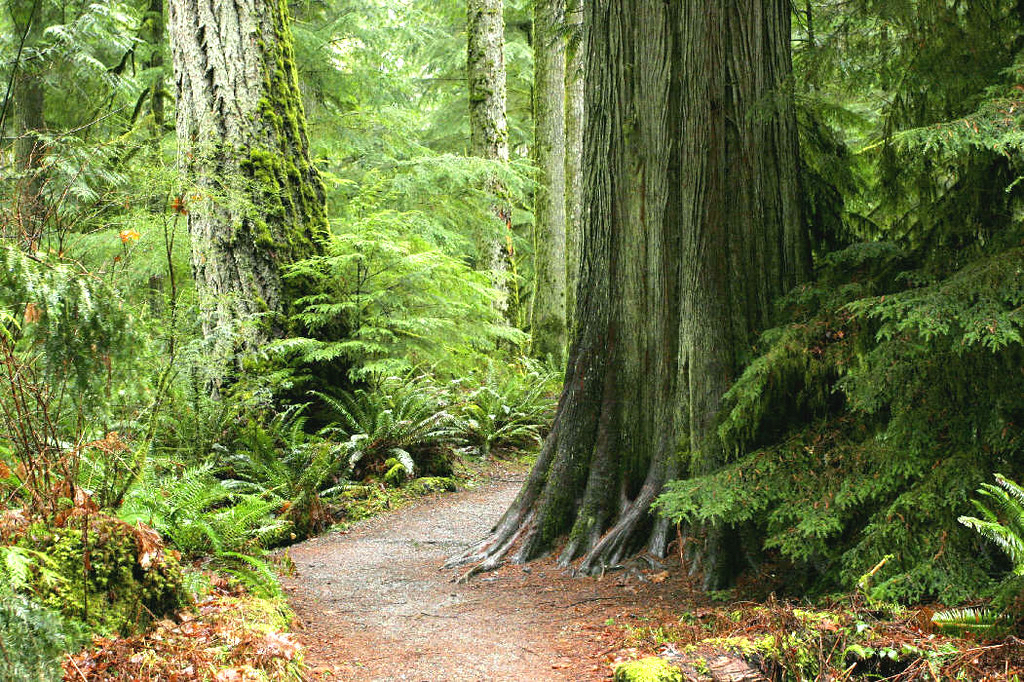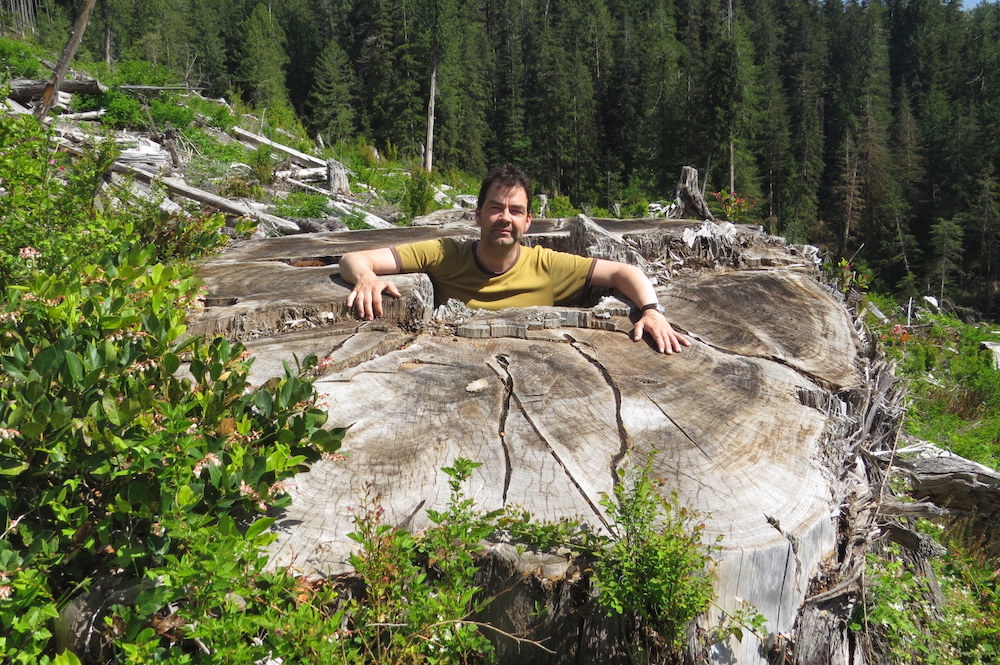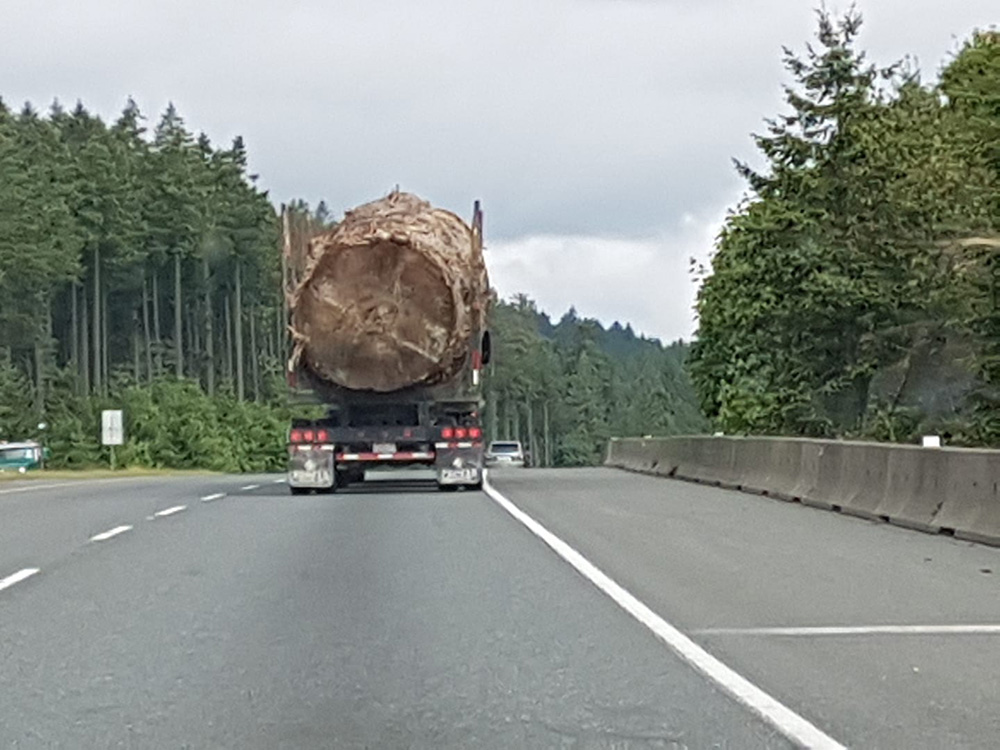Officials in British Columbia’s Forests Ministry understood that a regulation introduced in 2020 to protect big trees on public lands would have little impact. They designed it that way.
Internal records released to The Tyee in response to a freedom of information request confirm critics’ suspicions that the Special Tree Protection Regulation was meant to sound good to the public while continuing to protect the interests of the logging industry.
“Timber supply and economic impacts associated with the use of the proposed specifications are predicted to be insignificant when viewed on a provincial scale,” said a Forests Ministry memo dated Jan. 14, 2020 — some eight months before the government enacted the regulation.
The regulations apply to a dozen tree species on Crown and private lands managed under the Forest Act. Trees above set diameters, measured at chest height, are protected from logging. A hectare of forest surrounding each of those trees is also protected as a buffer.
For example, a western red cedar wider than 385 centimetres — more than 12 feet across — on the West Coast, or a Sitka spruce greater than 283 centimetres anywhere in the province, would be off-limits to logging. So would a Douglas fir on the coast with at least a 270-centimetre diameter, or one in the province’s Interior with 160-centimetre diameter.
The government and advocates for the forest industry have publicly claimed the regulation would create protection for some 1,500 trees, even though staff in the ministry’s forest analysis and inventory branch, as well as the compensation and business analysis branch, advised internally that it would do no such thing.
Many of the trees covered in the regulation would likely already be protected, the memo said.
“It is likely that much of this timber will already be inoperable,” it explained, giving the examples of trees protected because they are close to waterways or in other reserves where logging isn’t allowed. “[They also] can be used to complement existing landscape and stand-level biodiversity requirements further lessening any net timber supply impacts.”
If it turned out there was a small impact on logging, it would be balanced by “the anticipated increase in social operating licence associated with conserving the province’s largest and most iconic trees,” it said.
Ira Sutherland is the chair of the BC Big Tree Committee at the University of British Columbia’s faculty of forestry, which keeps a registry of the province’s largest known trees.
On one hand, Sutherland said, it could be seen as good news that many of the province’s largest trees would likely have already been protected without the regulation. On the other, it really points to the fact that lower size thresholds protection would be more effective and protect more than just the few most extraordinary trees.
“It really does make me wonder why they decided to make the thresholds so big if they really didn’t think it was going to be an issue at all,” Sutherland said. “I mean, I know the answer, just because industry has a powerful voice talking to government, so they kind of bow down to any concerns and try to make it as soft a landing as possible for industry, but yes, that’s definitely kind of disappointing.”
Before the province enacted the regulation, the BC Big Tree Committee had argued for lower thresholds and other ways to strengthen it.
Since the regulation went into force, others have expressed doubts about its effectiveness. When a photo went viral last year of a huge log on the back of a truck on Vancouver Island and government officials implied such a large tree would now be protected, critics questioned whether even that giant would have in fact met the threshold set out in the regulation.
And when two women from the Discovery Islands between Vancouver Island and the mainland measured trees near their homes, they were dismayed to realize “none of the few remaining giants, nor any of the first growth stumps, were big enough to qualify for provincial protection.”
Even in Cathedral Grove in MacMillan Provincial Park near Port Alberni, they found only three of the iconic trees met the province’s threshold. If the grove wasn’t in a park, they wrote, almost all of it could be logged, despite the regulation.

Greg Herringer, a forest technician working on Vancouver Island, said that since the regulation came into effect he has been searching intensively, both in his work and his private time, and found only two or three trees that would meet the new thresholds.
“Everybody in the industry wonders why they’re so high, because those trees don’t exist,” said Herringer. “It really is legislation built on cards. There’s nothing to back it up because all the large trees are gone and we’re never going to find the number out there they’re projecting.”
He’s particularly critical that the regulation lacks a role for the public in identifying trees that deserve protection, leaving it instead up to people involved in logging an area.
The regulation seems like it was put together hastily in an effort to appease the public desire for greater protection of old-growth forests and large trees, Herringer said. “In my opinion they should have waited and crafted a much better, more refined piece of legislation than putting together something that’s just full of holes and is criticized by everybody, even within the industry.”
Other records included in the response to The Tyee’s FOI request underscore that government officials developing the regulation, which would mandate a one-hectare buffer be kept around each tree protected, understood the impact would be minimal.
For example, in a Nov. 14, 2019 email to other ministry staff, the manager of strategic policy and intergovernmental relations, Tom McReynolds, had explained the decision to remove the economic analysis from a briefing note being drafted.
“I think there is agreement that the regulation won’t result in 1,500 [hectares] being removed from the [timber harvesting land base and/or allowable annual cut] and the economic impacts are overstated as a result of the assumptions being inaccurate,” he wrote.
Between when he wrote that email and when the regulation was made public, the government increased the size thresholds for several of the species, meaning even fewer trees would be large enough to be protected. Looking at some 2.3 million trees in the timber pricing branch of the ministry’s database, it aimed to set diameters high enough that just one out of about 10,000 trees would qualify.
‘Heartbreaking’ to see government’s failures
“I find it quite heartbreaking that our worst assumptions are being confirmed by what you’re sharing with me,” Jens Wieting, senior forest and climate campaigner for Sierra Club BC, told The Tyee.
“It’s really indicative of a government approach,” he said, “to consistently protect industry interests and adjusting almost every single step on this presumed path to protecting old growth in a way where the ecosystem has to give despite the fact there’s so little left to give.”

Premier John Horgan told The Tyee he’s very satisfied with his government’s progress on its old-growth strategy. “To the critics I say, get a life,” he said. “To the critics I say, listen to communities.”
Many of the critics of government forestry policy are disconnected from Indigenous people and fail to understand the continued role of logging in their communities, Horgan said.
“Have you been in a community that struggled with poverty for generations and when they see an opportunity, some do-gooder comes in with a Tilley hat and says you're all bad people, the government needs to do this, the government needs to do that. People need to stand up and support each other.”
In total, the ministry released 140 pages of records responsive to The Tyee’s request, but withheld others under sections of the Freedom of Information and Protection of Privacy Act allowing public bodies to keep cabinet confidences, policy advice and legal advice secret, as well as records that might harm law enforcement, intergovernmental relations, the financial or economic interests of a public body, the conservation of heritage sites or personal privacy.
The records that were released show officials decided to limit the number of species covered under the regulation, leaving out hemlock, tamarack, larch, Engelmann spruce, paper birch, Pacific dogwood, cherry and several other native trees.
In one email, a manager in the ministry explained that “to do that in a credible manner,” he only included species that had at least 10 representatives listed on UBC’s BC Big Tree Registry.
An earlier version of the policy, introduced in July 2019 while the ministry worked on the final regulation, would have retained significantly smaller trees and included thresholds for more than two dozen species.
Not everyone inside the ministry thought using the UBC registry as an indication of public interest made sense.
Clinton Webb, a land and resource specialist in the ministry, wrote to McReynolds and others and said the requirement that species must have at least 10 big trees in the BC Big Tree Registry to be protected “is not scientific or relevant.”
“The number of each species on the citizen registry isn’t a statistically valid measure of public interest or ecosystem representation,” he said. “Many of the 17 species thereby excluded are either ecologically rare or otherwise significant, or less easily recognized, and should be eligible for protection under the new regulation.”
There was also internal discussion about improving regional representation.
In a May 8, 2020, email, Adrian Walton, a landscape ecologist and data management team lead in the forest analysis and inventory branch, wrote: “Given that the significant tree policy is meant to address public concern that publicly-recognized significant trees may be removed through logging activities it may be best to define a significant tree based upon its regional significance.”
Most of the protected trees would be in limited areas of the coast and the Interior of the province, he said. He suggested dividing the coast and the Interior into northern or southern regions, or even smaller regions so that big trees across the province would be protected.
In response, McReynolds said in an email that the assistant deputy ministers wanted to involve the minister, then Doug Donaldson who has since retired from politics, in the decision on whether or not to use a more regional approach. Ultimately the government decided to stick with a single set of thresholds.
The records also provide insight on how the thresholds were determined.
Shawn Hedges, who worked on an early version of the policy and has since left the ministry, said in an email included in the FOI response that the initial thresholds he proposed were based on discussion with industry stakeholders, the BC Big Tree Committee at UBC, and analysis of the data in the committee’s registry.
They were “an attempt to balance the competing objectives of conserving bona fide big trees of cultural significance (a relatively small population) vs. a desire to minimize direct and indirect timber supply impacts to the greatest extent possible,” he wrote in a Jan. 8, 2020 email to the person who took over from him on the file.
His work on the thresholds included an analysis of ministry data as well as discussions with “smart folks” from Western Forest Products, Interfor and other industry representatives on the Resource Stewardship Tenures Committee, he said.
He noted that the size thresholds could always be reduced to protect more trees.
“If government concludes after a year or so that the thresholds aren’t capturing enough bona fide big trees it can simply amend the regulation,” he said. “Ditto for adding additional species if sufficient public interest is demonstrated.”
Other emails show how the new regulation would affect the operations of BC Timber Sales, which is owned by the provincial government.
It had been using a set of best management practices for coastal legacy trees since 2017 to guide which cedars, Sitka spruce and Douglas firs should be left standing. Those voluntary guidelines, which BCTS continues to use, included significantly lower size thresholds for protection.
In a March 19, 2020 email, Allan Powelson, who was then the director of sustainability and forestry for BC Timber Sales and is now the executive director, laid out what raising the thresholds it was using to match the ones the government was proposing would mean.
Where the BCTS policy protected 58 red cedars on the lands the agency managed, adopting the government’s threshold would protect just two. Instead of 64 Douglas firs being protected, just 18 would be. And while 25 yellow cedars and two Sitka spruce would have been protected, the government’s thresholds would have saved none.
Regulation could be more firmly rooted in science
There’s still room to improve the regulation, said Sutherland, the chair of the BC Big Tree Committee.
“We’re definitely still pushing for more regional representation based on ecosystems and maybe based more on social values, you know, where people actually interact with or appreciate these trees as well.”
The regulation should also be extended to protect every species and to include criteria to protect trees that are especially tall, he added. Overall, he said, the regulation could be more firmly rooted in science.
“It’s supposed to be a policy informed by analysis of the best available science, but it’s not quite there yet.”
It’s worth remembering, Sutherland said, that the government released the regulation before the Old Growth Strategic Review was completed and before Fairy Creek became a flashpoint, with more than 1,000 people getting arrested in an effort to end the logging of B.C.’s old-growth forests.
“I think that in the eyes of the government they were hoping that it was going to be an effective policy for increasing public relations and generating social licence, and sort of placating the public a little bit,” he said. “That might have made sense in the context of the day, but then everything blew up.”
The Sierra Club’s Wieting said that due to a combination of habitat destruction and climate change, time is running out to protect B.C.’s old-growth forests.
“People in B.C. have to be extremely alert after five years of talk and log,” he said. “We have gotten to the point where we cannot trust the government on this unless they use a new approach.”
There needs to be a shift in values so that old growth is off-limits to industrial logging by default, said Wieting, and then there needs to be discussions, with Indigenous peoples fully involved, about what exactly the exceptions can be.
That shift seemed to be underway after the Old Growth Strategic Review panel’s report came out in 2020 and the government committed to implement all its recommendations, he said.
And yet, despite the promised paradigm shift, Wieting said so far there’s no evidence that even the most at-risk old-growth forests are being protected through logging deferrals.
At the start of September, two years after the province released the old-growth strategy, Sierra Club BC and three other environmental groups issued a report card giving the government very low marks for progress thus far.
“The whole deferral theatre is almost perfect to create the illusion something big is happening,” said Wieting. “We are not actually seeing the impact because the government managed to allow tens of thousands of hectares to be on the chopping block, just like in previous years.”
Like with the Special Tree Protection Regulation, the government’s approach seems to be to continue encouraging logging as before, while reassuring the public that standards are changing, he said. ![]()
Read more: Labour + Industry, BC Politics, Environment
















Tyee Commenting Guidelines
Comments that violate guidelines risk being deleted, and violations may result in a temporary or permanent user ban. Maintain the spirit of good conversation to stay in the discussion.
*Please note The Tyee is not a forum for spreading misinformation about COVID-19, denying its existence or minimizing its risk to public health.
Do:
Do not: